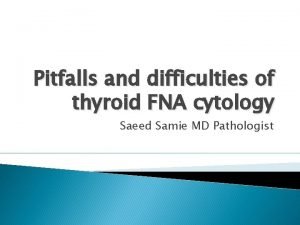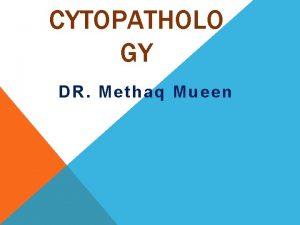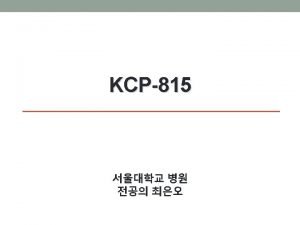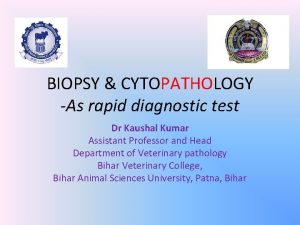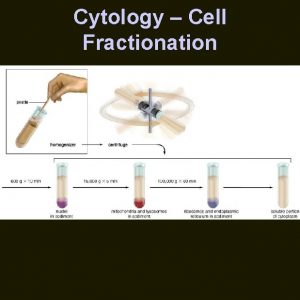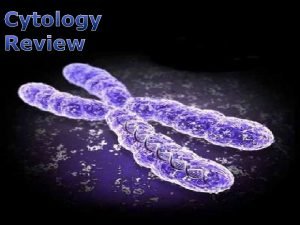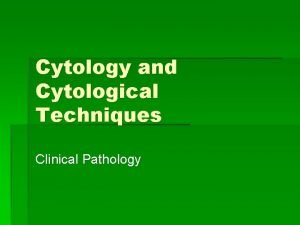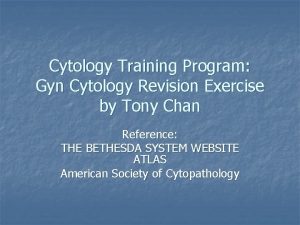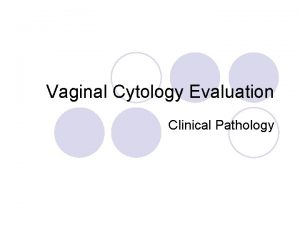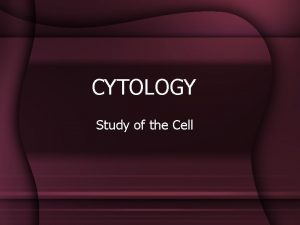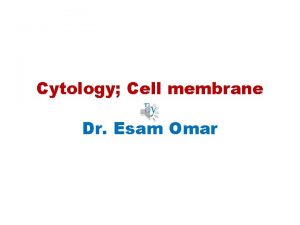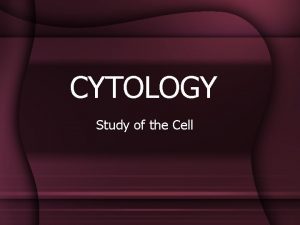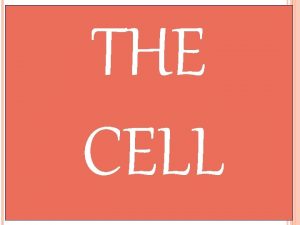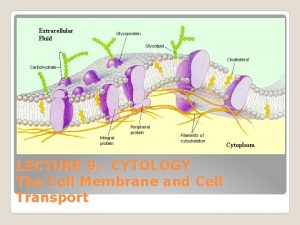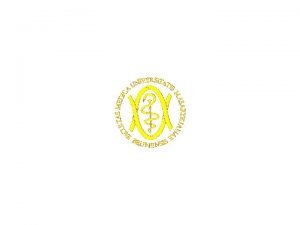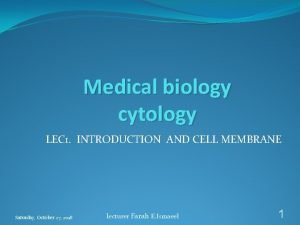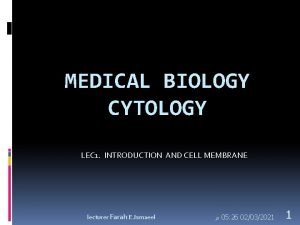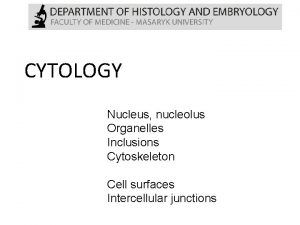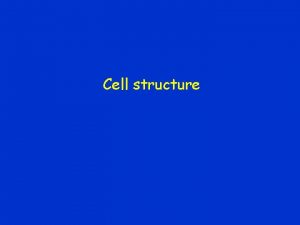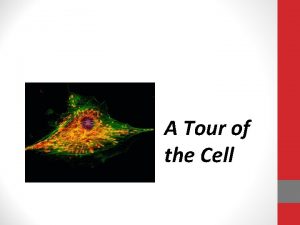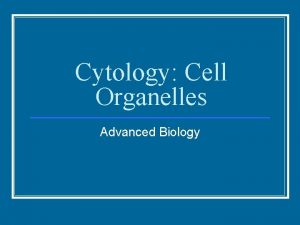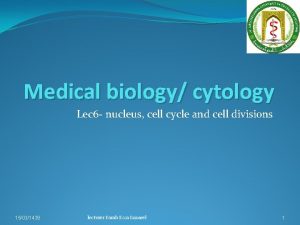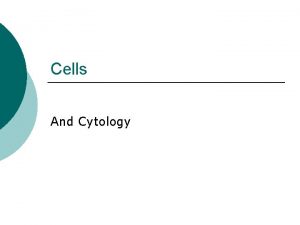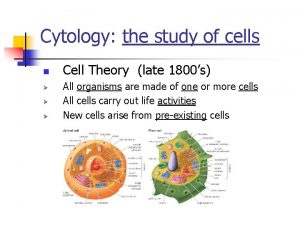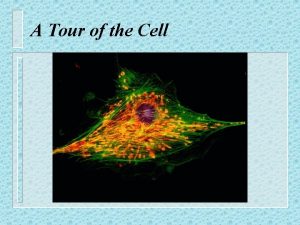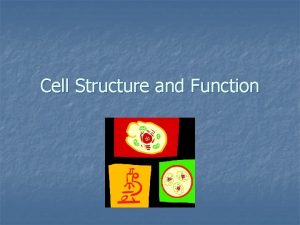The Cell Cytology History of the Cell Two






































- Slides: 38

The Cell: Cytology







History of the Cell – Two Ages

1. Cell Theory Age: 3 Scientists

Robert Hooke: 1 st Microscope/the cell

Anton van Leeuwenhoek: animal cells


Marcello Malpighi: “Father Microscopy” medicinal use of microscopes

2. Age of Microbiology – 3 scientists

Joseph Lister – proposed aseptic surgery

Robert Koch: germ theory – microbes cause disease

Louis Pasteur: vaccines, Pasteurization, disproved spontaneous generation

Spontaneous Generation: living organisms arise from non-living entities


Cytology: the study of the cell

Cell Theory – 3 postulates 1. All cells come from pre-existing cells 2. Cells are the basic unit of life 3. All living organisms are composed of cells

Two Types of Cells 1. Prokaryotic Cells: small simple cells -lack a nucleus -lack complex organelles -contain ribosomes 2. Eukaryotic Cells: complex cells -membrane bound nucleus -DNA in nucleus -complex organelles


Plant Cells 2. Cell Wall (Rigid) 1. Chloroplasts 3. Central Vacuole 4. Rectangular Shape

Animal Cells 2. Cell Membrane 1. No Chloroplasts 3. Many small vacuoles 4. Many Shapes


Cellular Levels of Organization Cell Tissue Organ System Organism

Cell Organelles: Cell’s “organs” - Cells are fully functioning systems

1. Cell Membrane: FX: regulates what enters/leaves the cell

2. Nucleus: FX: A. store DNA B. control center of the cell 2 A: Nucleolus: makes ribosomes

3. Cytoplasm: gel like substance in the cell FX: site of all cell activities

4. Endoplasmic Reticulum Two Types 1. Rough ER: makes and transport proteins (has ribosomes) 2. Smooth ER: lipid synthesis

5. Ribosomes: small organelles FX: produce proteins -500, 000 per cell

6. Mitochondria: rod shaped; double membrane FX: Produce energy molecules – adenosine triphosphate (ATP) “Powerhouse” of the cell

7. Golgi Apparatus: flat sacs FX: Package, sort, and transport cellular products

8. Lysosome: FX: to break down foreign contaminants Filled with enzymes

9. Microtubules FX: support the cell shape Cytoskeleton

10. Centrioles: Cylindrical structures FX: assist in cell division
 Cell biology and cytology
Cell biology and cytology Bethesda thyroid cytology
Bethesda thyroid cytology Abrasive cytology definition
Abrasive cytology definition Proteinaceous background cytology
Proteinaceous background cytology Exfoliative cytology
Exfoliative cytology Exfoliative cytology
Exfoliative cytology Gadolinium mrt
Gadolinium mrt History also history physical
History also history physical Hát kết hợp bộ gõ cơ thể
Hát kết hợp bộ gõ cơ thể Slidetodoc
Slidetodoc Bổ thể
Bổ thể Tỉ lệ cơ thể trẻ em
Tỉ lệ cơ thể trẻ em Chó sói
Chó sói Glasgow thang điểm
Glasgow thang điểm Alleluia hat len nguoi oi
Alleluia hat len nguoi oi Môn thể thao bắt đầu bằng chữ đua
Môn thể thao bắt đầu bằng chữ đua Thế nào là hệ số cao nhất
Thế nào là hệ số cao nhất Các châu lục và đại dương trên thế giới
Các châu lục và đại dương trên thế giới Công thức tiính động năng
Công thức tiính động năng Trời xanh đây là của chúng ta thể thơ
Trời xanh đây là của chúng ta thể thơ Mật thư anh em như thể tay chân
Mật thư anh em như thể tay chân 101012 bằng
101012 bằng độ dài liên kết
độ dài liên kết Các châu lục và đại dương trên thế giới
Các châu lục và đại dương trên thế giới Thơ thất ngôn tứ tuyệt đường luật
Thơ thất ngôn tứ tuyệt đường luật Quá trình desamine hóa có thể tạo ra
Quá trình desamine hóa có thể tạo ra Một số thể thơ truyền thống
Một số thể thơ truyền thống Cái miệng nó xinh thế chỉ nói điều hay thôi
Cái miệng nó xinh thế chỉ nói điều hay thôi Vẽ hình chiếu vuông góc của vật thể sau
Vẽ hình chiếu vuông góc của vật thể sau Nguyên nhân của sự mỏi cơ sinh 8
Nguyên nhân của sự mỏi cơ sinh 8 đặc điểm cơ thể của người tối cổ
đặc điểm cơ thể của người tối cổ V. c c
V. c c Vẽ hình chiếu đứng bằng cạnh của vật thể
Vẽ hình chiếu đứng bằng cạnh của vật thể Tia chieu sa te
Tia chieu sa te Thẻ vin
Thẻ vin đại từ thay thế
đại từ thay thế điện thế nghỉ
điện thế nghỉ Tư thế ngồi viết
Tư thế ngồi viết Diễn thế sinh thái là
Diễn thế sinh thái là

